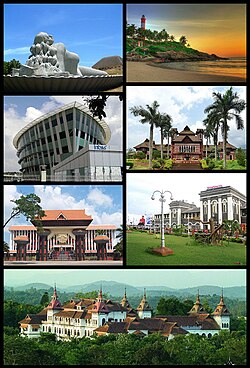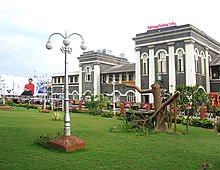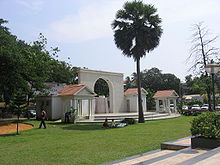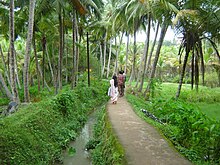Thiruvananthapuram,
formerly known as Trivandrum, is the capital of
the Indian state of Kerala. It is located on the west
coast of India near the extreme south of the mainland.
The city is characterized by its undulating terrain of
low coastal hills with narrow winding lanes and busy commercial
alleys.
Thiruvananthapuram
literally means Ananthapuri, "the city of Ananthan",
the Thiru (Great/Lord) Ananthan's Puram (City). The name
derives from the main deity of a Hindu temple at the centre
of the city. Ananthan is the serpent Sesha on whom Padmanabhan
or Vishnu reclines. The temple of Anantha, the Sri Padmanabhaswamy
temple is the most recognizable icon of the city.
With
a population of 889,191 (as of 2001) it is the second
biggest city in Kerala. The city, being the state capital
houses many government offices, organizations and companies.
Apart from being the political nerve center of Kerala,
it is also a major academic hub and houses several premier
educational institutions including the Kerala University.
Thiruvananthapuram is also home to many science and technology
institutions, the most prominent being the Vikram Sarabhai
Space Centre (VSSC).
History
Thiruvananthapuram
is an ancient city with trading traditions dating back
to 1000 BC. It was a trading post for spices like the
rest of ancient Kerala. However the ancient political
and cultural history of the city was almost entirely independent
from that of the rest of Kerala. The early rulers of the
city were the Ays. With their fall in the 10th century,
the city was taken over by the rulers of Venad.
The
rise of modern Thiruvananthapuram began with accession
of Marthanda Varma in 1729 as the founding ruler of the
princely state of Thiruvithamkoor (Travancore). Thiruvananthapuram
was made the capital of Travancore in 1745. The city developed
into a major intellectual and artistic center during this
period of time. The golden age in the city's history was
during the mid 19th century during the reign of Maharaja
Swathi Thirunal and Maharaja Ayilyam Thirunal . This era
saw the establishment of the first English school (1834),
the Observatory (1836), the General Hospital (1839) and
the University College (1873).
The
early 19th century was an age of tremendous political
and social changes in the city. The Sree Moolam Assembly,
established in 1904 was the first democratically elected
legislative council in any Indian state. Despite not being
under direct control the British Empire at anytime, the
city however featured prominently in India's freedom struggle.
The Indian National Congress had a very active presence
in the city. This era also saw the establishment of the
University of Travancore in 1937 which later became the
Kerala University.
After
the withdrawal of the British in 1947, Travancore chose
to join the Indian union. In 1949 Thiruvananthapuram became
the capital of Thiru-Kochi, state formed by the integration
of Travancore with its northern neighbour Kochi. When
the state of Kerala was formed on November 1, 1956, Thiruvananthapuram
became the capital of the new state.
With
the establishment of TERLS (Thumba Equitorial Rocket Launching
Station) in the 60s, Thiruvananthapuram became the cradle
of India's ambitious space program. The first Indian space
rocket was developed and launched from the Vikram Sarabhai
Space Centre (VSSC) located in the outskirts of the city
in 1966. Several establishments of the Indian Space Research
Organization (ISRO) were later established in Thiruvananthapuram.
A
major milestone in the city's recent history was the establishment
in 1995 of Technopark, an IT park. This placed Thiruvananthapuram
on the IT map of India and it is today one of most promising
in the country in terms of competitiveness.
The
city was officially known as Trivandrum till 1991.
The name is still in common use and most non-Keralites
prefer to use Trivandrum.
Geography
Thiruvananthapuram
is located at 8.5° N 76.9° E on the west coast,
near the southern tip of mainland India. The city covers
an area of about 250 square kilometers, sandwiched between
the Western Ghats and the Arabian Sea. The average elevation
is at sea level.
The
city can be divided into two geographical regions, the
midlands and the lowlands. The midland region comprises
of low hills and valleys adjoining the Ghats. This area
has high agricultural activity and crops like paddy, tapioca,
spices and cashews are cultivated here. The lowland is
a narrow stretch comprising of shorelines, rivers and
deltas, dotted with coconut palms. The major rivers that
flow through the city are the Karamana river, the Neyyar
and the Vamanapuram river.
A
third region the highlands form the eastern suburbs of
the city. Several cash crops like rubber, tea, cardamom
etc. are grown here. The highest point is the Agasthyarkoodam
which rises 1890 m above sea level. Ponmudi and Mukkunimala
are hill-resorts near the city.
Climate
The
city has a tropical climate and therefore does not experience
distinct seasons. The mean maximum temperature 34 °C and
the mean minimum temperature is 21 °C. The humidity is
high and rises to about 90% during the monsoon season.
Thiruvananthapuram
is the first city along the path of the south-west monsoons
and gets its first showers in early June. The city gets
heavy rainfall of around 1700 mm per year. The city also
gets rain from the receding north-east monsoons which
hit the city by October. The dry season sets in by December.
December, January and February are the coldest months
while March, April and May are the hottest. The winter
temperature comes down to about 18 °C and summer temperatures
can sometimes go as high as 37 °C.
Economy
Inside
a Technopark building
The
economy of Thiruvananthapuram is based on the tertiary
sector with about 70% of the workforce being employed
as government servants. Industrial and commercial activities
are comparatively low unlike the other cities of Kerala
namely Kochi and Kozhikode.
Since
the establishment of Technopark in 1995, Thiruvananthapuram
has steadily grown into a competitive IT centre. Technopark
houses global majors like Infosys, TCS, Tata Elxsi, Alliance
Cornhill, US Technologies, McKinsey & Co., Ernst &
Young etc. The park provides employment directly to 5,500
people. With the expansion plans to be completed in 2007-08,
this figure is to rise to about 30,000.
There
are around 20 government owned and 60 privately owned
medium and large scale industrial units in Thiruvanathapuram.
The major employers are the Kerala State Industrial Development
Corporation (KSIDC), Keltron, Travancore Titanium and
Hindustan Latex, all government owned. There are also
about 30,000 small scale industrial units employing around
1,15,000 people. Traditional industries include handloom
and coir.
Other
major organizations of economic interest are the Chithranjali
Film Complex, Kinfra Apparel Park, Kinfra Audio Visual
Park, Trivandrum Rubber Works, Kerala Automobiles and
the English India Clay Ltd.
Commercial
activity is quite low mainly due to the absence of natural
harbours. However this might soon change with the construction
of the proposed Vizhinjam container terminal.
Civic
Administration
The Kerala legislative assembly
The
city is administered by the Trivandrum Corporation headed
by the Mayor. The city council is democratically elected
and comprises of 25 members representing the different
city wards. Several agencies work under or in partnership
with the Corporation including the Trivandrum Development
Authority (TRIDA) and Trivandrum Road Development Corporation.
Most
of the city comes under the Thiruvananthapuram Lok Sabha
constituency. Some northern wards of the city come under
the Chirayinkeezhu constituency. The city contributes
to 6 legislative assembly seats namely Kazhakootam, Thiruvananthapuram
North, Thiruvananthapuram West, Thiruvananthapuram East,
Nemom and Kovalam.
The
city police is headed by a Police Commissioner an officer
of IPS rank. The city is divided three police sub-divisions
headed by Assistant Commissioners. There are also two
traffic sub-divisions. A women's cell and a narcotics
control cell also operate in the city. There are two armed
state police camps and a unit of the Central Reserve Police
Force (CRPF).
Thiruvananthapuram
is the capital of Kerala and hence the state legislative
assembly and secretariate are located here. The city is
also the headquarters of the Thiruvananthapuram district.
Transport
Indian Coffee House building
Within
the city, city buses and autorickshaws provide means of
transportation. Two-wheelers, especially scooters and
motorcycles are the favored means of personal transportation
on the roads mainly owing to the narrow nature of the
roads.
The
intra-city public transport is dominated by the state-owned
KSRTC (Kerala State Road Transport Corporation). There
are also private bus services, but are limited in number.
The city services of KSRTC operate from 5 depots namely,
the City depot, Vikas Bhavan, Peroorkada, Pappanamcode
and Vellanad. These services were revamped in 2005 with
the introduction of modern buses and electronic ticketing
mechanisms. The central city bus terminal is located at
East Fort, near the Padmanabha Swamy temple. The long-distance
bus station is located 1km away at Thampanoor. Buses from
it go to all major towns and villages in the state as
well as big cities in India such as Kochi, Bangalore and
Chennai.
The
central railway station is also located at Thampanoor
in the heart of the city, 8 km from the airport. It is
a very important terminus which handles over 50 trains
daily. The city is well connected by rail to almost all
major cities in India. Trivandrum is the first major city
along the second longest train route in the world, Kanyakumari
to Jammu. A second satellite station was opened in 2005
at Kochuveli, near the International Airport.
Thiruvananthapuram's
international airport, with direct flights from the Middle
East, Singapore, Maldives and Sri Lanka is the gateway
to the tourism-rich state of Kerala. Indian Airlines and
Jet Airways are the domestic airlines operating from here.
Air India, Gulf Air, Kuwait Airways,Silkair, Srilankan
Airlines and Air Maldives are operate the international
flights. There are also two military airports one near
the civilian airport and the other at the Southern Air
Command of the Indian Air Force in Akkulam.
The
exponential growth of the services and IT based sectors
coupled with its prominance as the state capital and tourist
centre has caused considerable strain on the transport
infrastructure of the city. To tackle this crisis, several
construction projects are now underway including the construction
of several underpasses and flyovers, scheduled to be completed
by early 2007.
Demographics
The
city has a population of 889,191 according to the 2001
census, making it the 2nd most populous in the state and
the 30th in the country. Within the city, the density
of population is about 3,500 people per square kilometer.
The district has a literacy rate of 88%. Unlike most other
Indian cities there are more women in Thiruvananthapuram
than men, with the sex ratio being 1037 females to every
1000 males.
Hindus
comprise of 62% of the population, Christians are about
20% and Muslims about 15%. The major language spoken is
Malayalam. English and Hindi are also widely understood.
There is also a prominent minority of Tamil speakers and
a few Tulu and Konkani speakers.
Culture
Thiruvananthapuram
has a rich cultural background, with the rulers of erstwhile
Travancore taking an active interest in development of
arts and culture. Thiruvananthapuram has produced several
great artists, the most famous ones being Maharaja Swathi
Thirunal and Raja Ravi Verma.
Maharaja
Swathi Thirunal was a great composer and played a vital
role in the development of Carnatic music. He is widely
credited with introducing the violin in to the world of
classical Carnatic music. A music college in his name
exists today in the city. Raja Ravi Verma was an illustrious
painter with global recognition. His contributions to
Indian art are substantial. Most of his famous paintings
are preserved at the Sree Chithra Art Gallery in the city.
The
Padmanabha Swamy Temple and the fort surrounding it, the
Napier Museum and Zoo, the VJT hall, Palayam Mosque and
Church are among the prominent heritage buildings in the
city. The Veli Lake and Shangumukham beach are home to
various sculptures of noted sculptor Kanhai Kunjiraman.
Thiruvananthapuram
easily disguises itself as a laid back quiet city to the
casual observer. However beneath it, there is a humdrum
of cultural activity. The city comes to life during the
festival season of Onam in August\September and during
the tourist season later in the year. The state government
conducts the tourism week celebrations every year during
Onam with cultural events taking place at various centers
in the city. The other major events include the annual
flower show, the Attukal Pongala, the Aaraat
at Padmanabha Swamy Temple, the Beemapally Uroos,
Vettucaud Perunaal etc.
Education
Thiruvananthapuram
is a major academic hub. The University of Kerala is located
here. The city also has several professional education
colleges including 15 engineering colleges, 8 medical
colleges and 2 law colleges. The College of Engineering
Trivandrum is one of the prominent engineering institutions
in the country.
There
are about 900 schools in Thiruvananthapuram district.
The public schools are run directly by the state government.
They follow the syllabus prescribed by the state government.
In addition to this there are also four Kendriya Vidyalayas
run directly by the central government which follow the
CBSE syllabus. Most parents however prefer to send their
children to private schools that are affiliated to either
CBSE or ICSE boards.
Media
Daily
newspapers are available in English and Malayalam. The
English newspapers with editions from Thiruvananthapuram
are The New Indian Express, The Hindu and
The Pioneer. The major Malayalam newspapers are
Mathrubhoomi, Malayala Manorama, Kerala
Kaumudi and Desabhimani.
Most
Malayalam TV channels are based in Thiruvananthapuram.
The government owned Doordarshan began broadcasting from
here in 1981. Asianet was the first private Malayalam
channel and began operations in 1991. The other channels
now based in Thiruvananthapuram are Surya TV, Amrita TV,
Kairali TV, Kiran TV and Asianet Plus. The local cable
services are provided by ACV and Siti Cable and they provide
a bouquet of local channels in addition to all the Indian
channels. DTH services are available through Doordarshan
Direct Plus and Dish TV. All India Radio has an AM (1161 MHz)
and an FM (101.9 MHz) station for the city. There
are no private radio stations.
There
are several cinema halls which screen movies in Malayalam,
Tamil, English and Hindi. There are also two movie studios
in the city, Chithranjali and Merryland.
The
basic telephone services are provided by BSNL, Reliance
and Tata Indicom. The cellular networks operating in the
city are BSNL CellOne, Airtel, Idea Cellular, BPL Mobile
(all GSM) and Reliance (CDMA). The number of mobile phone
connections have increased exponentially since the late
90s. Broadband internet services are provided by ACV Dataline,
Siti Cable and BSNL DataOne. The major dial-up internet
providers areBSNL NetOne, Kerala Online and KelNet among
others.
Sports
The
most popular sports are Football and Cricket. Basketball,
Badminton and Volleyball are also popular, mostly in schools.
The Chandrasekharan Nair Stadium is a prominent football
stadium and has hosted both national and international
level matches. The University stadium has hosted two international
cricket matches and is also used for athletics. The Jimmy
George Sports Complex, the GV Raja Sports School and Lakshmi
Bhai National College for Physical Education (LNCPE) are
the other major sports establishments in the city. The
city also has a golf links and a tennis club both located
at Kawdiar.
The
city fields two football clubs SBT and Titanium, both
in the second division of the National Football Leauge.
Science
and Technology
Thiruvananthapuram
is a Research and Development hub in the fields of space
science, information technology, bio-technology, medicine
and so on. It is home to a cluster of research centres
to rival any in the world, which include














































